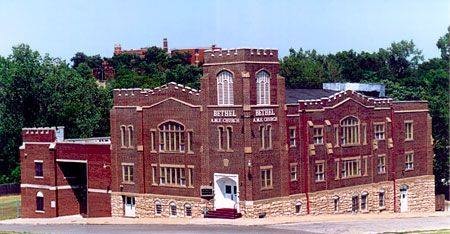Bethel A.M.E. Church
Introduction
Text-to-speech Audio
Construction of this church began in 1912 with a basement structure that provided a home for a congregation that started with just eighteen members the year prior. Bethel A.M.E. became the city's first south of 18th Street, and by 1917, the congregation had grown to 170 members which reflected the growth of the African American population in this part of Kansas City. In 1926, the construction of an auditorium and Sunday School above the basement edifice was complete, providing space for a congregation that had grown to around seven hundred members. The congregation added a parsonage in 1942 and completely led numerous projects to improve and expand the church in the decades that followed culminating in the completion of the upper auditorium in 1976. In the decades that followed, the congregation has supported apprenticeship, employment, and educational programs, food assistance, and housing for senior citizens in the neighborhood.
Images
Kansas City's Bethel A.M.E Church

Backstory and Context
Text-to-speech Audio
This historic church dates back to 1911 when Sister Kitty Raynor held church and Sunday School services in her home. The group grew quickly and Harrison Williams, who had supported Raynor's work, believed there were enough interested families in the area that they should consult with A.M.E. leaders about starting a new mission. There had been attempts to create a new congregation in this area, but it was not until the effort by Raynor and Williams that there was enough progress. With the support of Bishop H.B. Blanton Parks, the group acquired this property and laid a cornerstone in 1912. Bethel A.M.E. began as a single-story structure but grew quickly as the population of this area increased. Today, the congregation remains a central institution in the community as it enters its second century.
In the 1970s, the historic church was located on one of the proposed routes of a planned South-Midtown Freeway which became Highway 71. The project displaced thousands and disproportionately affected predominantly Black neighborhoods, but the extensive project also included numerous compromises such as intersections with stop lights to avoid bisecting neighborhoods with a high-speed freeway. The activism, agency, and political power of community leaders led to a variety of concessions such as including a parkway section with stop lights and building architecturally substantial bridges. And while some historic buildings were lost along with thousands of homes, one cannot but help to notice that the road bends slightly to the west when approaching this historic church from the south.
Cite This Entry
Admin, Clio and David Trowbridge on behalf of Black Archives of Mid-America. "Bethel A.M.E. Church ." Clio: Your Guide to History. November 2, 2022. Accessed March 20, 2025. https://theclio.com/tour/2422/3
Sources
Our Heritage, Bethel A.M.E. Church website. Accessed July 11th 2022. http://www.bethelkcmo.org/our-heritage.html.
Hogan, Suzanne. Highway 71 And The Road To Compromise, June 3rd 2014. Accessed July 11th 2022. https://www.kcur.org/community/2014-06-03/highway-71-and-the-road-to-compromise.
https://www.facebook.com/BethelChurchKCMO/photos/a.249720301876388/249720308543054/

